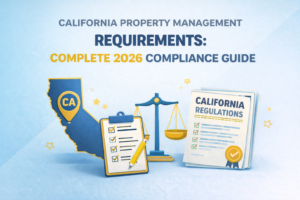
Property Management and OSHA: Navigating Workplace Safety Standards
Laws are there to protect people, and that’s why you’ll find many of them in the United States. One crucial law is called OSHA, which stands for The Occupational Safety and Health Act.
It has protocols that workplaces need to follow to ensure safety. And guess what? Property owners are not exempt from this law either! OSHA has reported numerous cases related to property management where penalties were imposed for not adhering to the rules.
You definitely wouldn’t want that for your property management business; no sane person would want that, actually.
So, what exactly is this OSHA law? What does it entail? And why should property managers take it seriously? Let’s find out!
What is OSHA?
Let’s begin by understanding the basics of this law and when it came into effect.
The Occupational Safety and Health Administration (OSHA) plays a crucial role as an agency in the United States, operating under the Department of Labor.
OSHA was established through the Occupational Safety and Health Act of 1970 to ensure safe and healthy working conditions for American workers. They achieve this by setting and enforcing standards and providing training, outreach, education, and assistance.
Moreover, it is more than just another regulation to comply with. OSHA has a pretty broad scope – it covers most private sector employers and their workers, and even some public sector employers and workers in the 50 states and certain territories and jurisdictions under federal authority.

The agency aims to prevent work-related injuries, illnesses, and deaths. They do this by issuing and enforcing rules, also known as standards, for workplace safety and health. These rules cover all hazards, like toxic substances, harmful physical agents, mechanical dangers, and unsanitary conditions.
OSHA standards may prescribe specific practices, such as using safety equipment or broader guidelines for general safety principles. In addition to setting these standards, OSHA is responsible for conducting inspections to enforce its standards.
These inspections may be complaint-driven, in response to a specific workplace incident, or part of a targeted program focusing on high-hazard industries or workplaces.
OSHA’s impact on workplace safety in the U.S. has been significant. Since its inception, the agency has played a crucial role in reducing the number and severity of workplace injuries and improving the overall health and safety environment in American workplaces.
OSHA for Property Managers?
Now that you’ve grasped OSHA, you might wonder, “What does it mean for me as a property owner, and why should I take it seriously?
These two examples below help you understand why complying with this law as a property manager is essential!
Olivet Management, LLC in New York, got a significant smackdown in one of the most severe OSHA enforcement actions. They were hit with 45 willful violations and initial fines of $2,352,000. They knowingly exposed workers to lead and asbestos without taking any safety precautions!
And that’s not all. OSHA also accused them of not telling waste haulers that they were transporting hazardous substances, putting even more people at risk and causing improper disposal of the materials.
In another case, this worker was at Sun Communities, Inc., a property management firm in North Carolina. They made a huge mistake by adding a whole bunch of chlorine crystals to just one bucket of water.
The mixture was way too strong and started foaming. The poor workers couldn’t control it and got splashed with that toxic stuff. They even ended up breathing in chlorine fumes.
The company got hit with a bunch of penalties for this mess. They got fined $2000 for not providing protective gear and another $4000 for not giving workers facial protection when dealing with chemical hazards. That’s not all, though.
They also got fined for not having a way for workers to wash out their eyes after exposure to toxic chemicals, not having enough first aid supplies, not training their staff to give medical help, and not properly warning employees about the dangers.
So, if your place has a pool, it’s a good idea to check out OSHA’s rules on storing and handling swimming pool chemicals safely. Trust me, you don’t want to end up like these guys!
Common OSHA Regulations in Property Management
When we talk about OSHA regulations in property management, we’re just talking about the basic safety measures that help keep everyone safe and sound.
These rules aren’t meant to confuse or overwhelm anyone; they’re simply the critical checkpoints we must go through to ensure a property is secure for living or working.
One important thing to consider is having handrails installed on staircases.
According to OSHA, it’s not just about looks – these handrails are crucial for preventing slips, trips, and falls in properties with multiple floors. Properly maintaining and securely installing these handrails can significantly reduce the risk of accidents.
Another vital aspect to consider is fire safety. According to OSHA regulations, residential and commercial properties must have working fire alarms and extinguishers.

It’s not just about installing them; these safety devices need to be regularly tested and maintained to ensure they actually work. In case of an emergency, a non-functioning fire alarm or extinguisher is as good as useless.
OSHA also highlights the importance of proper lighting and visibility, especially in common spaces, stairwells, and parking lots. Regarding properties that deal with hazardous materials, especially commercial ones, OSHA sets strict guidelines for handling, storing, and disposing of them.
The property managers are responsible for ensuring that all the necessary safety protocols are in place to keep everyone safe from the potential dangers of these materials.
Property managers play a crucial role in implementing these regulations, turning them from mere paper directives into practical safety measures. As part of this process, they conduct regular inspections like checking fire extinguisher charges and ensuring well-lit hallways. These actions aren’t just about compliance; they’re essential for keeping tenants, visitors, and workers safe and secure on the property.
Benefits of OSHA Compliance for Property Managers
Regarding property management, embracing OSHA compliance goes beyond simply meeting regulations. It’s a strategic move that brings a host of benefits.
By prioritizing safety measures, not only do you ensure tenant satisfaction and a secure environment, but you also reduce the risk of accidents and associated liabilities.
It’s a cost-effective approach that saves expenses in the long run while boosting the property’s reputation, attracting top-notch tenants, and fostering a positive atmosphere.
Compliance isn’t a burden. It’s a proactive investment in operational efficiency, legal adherence, and the overall well-being of the property and its occupants. Ultimately, it’s a mark of responsible and forward-thinking property management.
Conclusion
In essence, OSHA compliance isn’t just about meeting legal obligations; it’s an investment in the overall well-being of the property and its occupants. It’s a testament to a property manager’s dedication to creating a secure and desirable living or working space. Compliance isn’t just good practice; it’s a testament to responsible property management.
Additional Resources
OSHA’s Guide to Workplace Safety
Table of Contents
Stay Updated
Subscribe to get the latest news, industry trends, blog posts, and updates...




